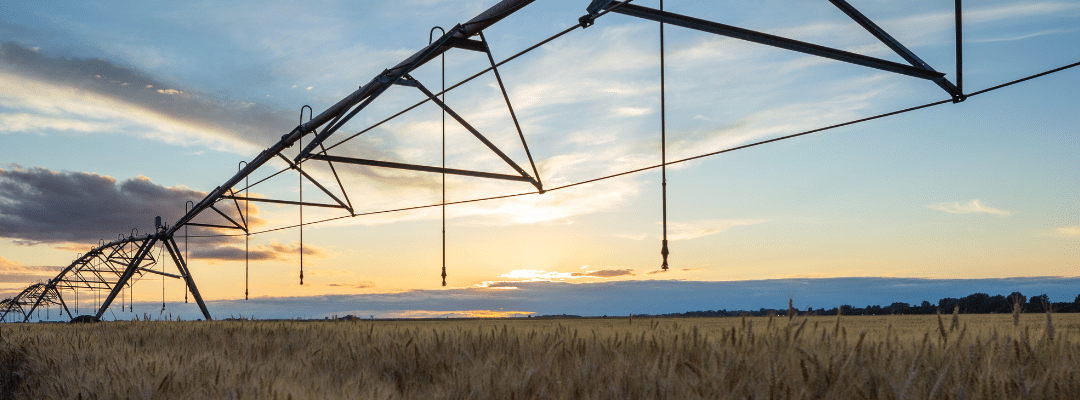Drought has been a hot topic and complicated battle for agriculture this year, leaving some at a loss of next move to offset its effects. This has been especially troublesome for agriculture-heavy states, like the Midwest. In Illinois alone, 99% of the state is dry or in drought in 2023 – causing challenges across many fields.
This in no way means yields are doomed – thanks to the resilience of this industry, there is hope. Maintaining optimal growing conditions with little to no water is no easy task to take on alone, but with the help of innovative tools and strategies we stand a fighting chance.
With July being Smart Irrigation Month, we want to highlight some of the ways that you can better inform your irrigation practices via remote sensing and aerial imagery technologies. To better preserve resources, ensure productivity, and reduce costs, it is critical to explore and leverage solutions of these means.
What Does “Smart Irrigation” Mean?
One of the biggest buzzwords in agriculture right now is “sustainability,” and has been the fuel behind uncovering innovative technologies, practices, and resources. In more recent years, the concern around environmental impact has heightened as more effects from climate change have become more apparent. Whether it’s monitoring greenhouse gas emissions or limiting resource usage, sustainability has driven the evolution of industries across the world.
In agriculture, key resources dwindling and becoming more expensive is no foreign concept – but it is still a challenge, especially with vital limited resources. And, unfortunately, water is not an unlimited resource and calls for preservation – with some states going so far as limiting water use per year. With the growing population and its associated demands, the competition for this limited amount of usable water is expected to rise.
Smart irrigation works to better inform how and where irrigation practices will be executed, helping to use water more efficiently and precisely. With the help of technology, most often sensors in the ground to measure moisture content, the idea is to inform what areas are in need of water and when they need it. This ensures that crops are getting the right amount of water at the right time. And limiting input use doesn’t mean sacrificing quality; precise application ensures the areas that are most in need of water are getting the inputs necessary – helping to promote productivity.
Aerial Imagery’s Role in Smart Irrigation
Much like smart irrigation, ag technologies have evolved throughout the years to keep up with changing conditions and demands. Drought is in no way a new issue for agriculture; it has been fueling innovation and adaptation for generations.
New ways to mitigate the impacts from drought have evolved to more advanced and modern technologies. When looking to better inform irrigation, remote sensing sits at the core to uncover key insights. I mean, how else would you get precise input use without precision ag technology?
For most smart irrigation systems, in-soil sensors provide an indication of moisture content to alert the irrigation system whether the area needs water. Advancing remote sensing capabilities to include high-resolution aerial imagery can provide a bird-eye’s view to see what is happening across your fields, picking up on key indicators into performance – like crop stress, vigor, and health. Having access to real-time data of your field or plot in its entirety allows you to gain accurate and fast insight into how drought is impacting crops and informs timely decisions to be made.
While the in-field sensors provide a snapshot in time of how you should be watering your fields, based on what’s happening in your soil, aerial imagery can provide a different perspective to inform what irrigation strategy may work best for your crops. Crop type, soil content, weather conditions, and growth stages can all change the demands for water; so, using a combination of in-soil sensors and aerial imagery can truly unlock the insight necessary to understand crop health and how water management practices are impacting performance. The data analytics captured by aerial imaging technology can help in informing early irrigation strategies to post-season analysis to better prepare for the following growing season.
Crop Health for instance, is one of the most popular analytics that provides insight into potential water stress and overall plant vigor. Whether capturing the data via an ag drone system or leveraging satellite data, vegetative indices, like Normalized Difference Vegetation Index (NDVI) and Normalized Difference Red Edge (NDRE), provide even deeper insight into your crops. With water stress being one of the most significant factors that impact crop health, early indication can help fuel decisions regarding irrigation strategies.
Post-season field or plot analysis to inform future decisions to avoid the same issues as past seasons. With the help of analytics like Elevation & Hydrology, you can model water flow within the field and better inform management decisions – like irrigation systems.
Aerial imagery unlocks an easy and accurate look into areas that are being impacted by dry conditions, helping to pinpoint what areas need to be focused on. Instead of using irrigation systems constantly throughout an entire field, you’re able to hone in on specific areas that need attention.
A More Efficient and Sustainable Future
Improper water usage is not only wasteful but can have detrimental effects on the environment. Excessive water use can lead to other problems, like runoff, that can contaminate unintended areas. Not only that, but with high competition for water resources, by preserving and reducing the amount of water used in agriculture operations we are building that sustainable future.
Leveraging smart irrigation systems is essentially a win-win situation for everyone, when executed correctly. Adopting smart practices is a steppingstone in building a sustainable and productive future. Engaging in efficient and sustainable irrigation can help improve food production while overcoming pressures that are building surrounding water resources.
And not only is it sustainable, but it is also cost efficient by limiting inputs and therefore expenses. With input costs seemingly rising by the day, reducing and avoiding waste with precision application is an effective way to reduce costs. Efficient irrigation reduces water loss and crop inputs, without sacrificing yield and crop quality – promoting both profitable and sustainable practices.
Sustainability and profitability don’t have to be separate entities, as we can ensure that both are achieved. Just because inputs are being reduced does not mean that yields are suffering; it is just a smarter solution to the challenges facing agriculture.


